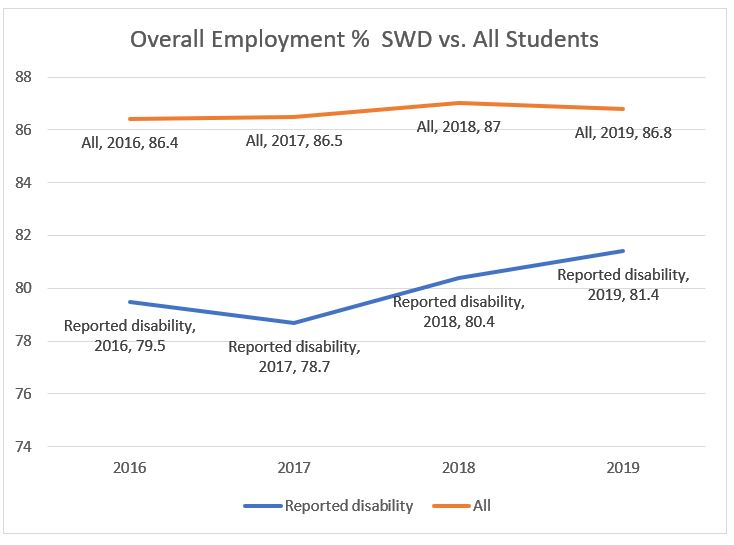Higher Education Employment Outcomes and Students with Disability

The year is 2020. The Covid-19 pandemic in Australia is showing some flattening of the curve, and now we are cautiously starting to look toward the future. During this incredible time, many Universities have been grappling with the rapid shift online - and disability practitioners have been working overtime to support students with access through negotiations, work-arounds, trialling innovative ideas, and more.
With all of this under consideration, there is a looming issue that is boiling away in the background. When the next round of students makes it through graduation, what does work look like? And what could the impacts be for students with disability? What systemic innovation can be produce for this talented pool of graduates to level the field?
To talk about this, we need some context. Deep within the 2019 Graduate Outcomes Survey data table, tucked neatly away in “Table 15” sits the student equity data – employment outcomes 1. This data didn’t make the report 2, however, there was some very typical, and then some positive news in the data tables for graduates with disability pre-Covid-19.
When you sort the results for equity groups from ‘highest to lowest’ for overall employment rates in 2019, Students with Disability sit in position #15 (of 16). Students with Disability remained the second lowest performing equity group in Higher Education when it comes to getting work as of 2019, and they were also the fastest growing equity group across 2013-2018, with a growth rate of 50% (all students grew by 12.6%)3.
Now for the positive news - Students with Disability made a 3.8% gain in full-time employment rates from 2018-2019, versus the all student indicator, which fell 0.7%. Further, the trend for Students with Disability and their overall employment rate has also seen forward marching movement compared to the all-students indicator - as charted below.

These indicators, when reported in isolation, are heartening for those of us who work in this space. However, the gaps are still significant - and a pandemic has struck, throwing many of us off course.
So what’s next? If correlation were causation, we could be looking at a sharp up-tick in employment rates 2020-2021. At the top of the list: the highest performing equity group in terms of overall employment in 2019 was - external students! Irony has no boundaries. Yes – to the academic purists reading this, I know you immediately thought of the underlying considerations: 2019 external students – were they already working? Will they still be working now?
Now, on to the innovation and practice. Here are some thought-starters for Universities and graduate employers when it comes to employment for students with disability and providing advice, into the future:
- Workforces have been forced to be more flexible overnight, with a recent poll showing 88% of Australian companies have required or encouraged remote working 4. Perhaps - some employers will find the silver lining? This shift could pave the way for a number of opportunities for students with disability. Share this messaging with your students and applicants about reasonable adjustments and options for remote working, where appropriate. Once an organisation demonstrates capacity to do something, it is hard to un-demonstrate.
- It is fair to say that we should hire people for their potential output, not for the appearance of somebody in an office rushing around looking busy. International research in to social norms does back this somewhat 5: Showing up at 9am and demonstrating a focused appearance is arguably linked to perceived productivity. It’s time to uncouple perceptions of movement and activity from the measurement of success or lack thereof in our employees.
Thankfully, workforces (unless they have sophisticated usage monitoring) now have little option but to rely on what the employee working remotely produces, instead of what they see as indicators of ‘busy-ness’. This outputs-based leadership (even if unintentional) enables flexibility and a trusting, welcoming culture. The computer movement software programmers are in overdrive however - with some companies already running in the opposite (wrong?) direction.
- Many requested adjustments from employees with disability are about flexible time and environments 6. One US sample of 2,744 employer adjustments showed 58% cost nothing (therefore, a decision only), and the average cost was $500 7. This is relatively comparable to Australia, with a 2013 survey highlighting that 50% of government funded workplace modifications cost less than $1,000*. Could our instant need for more flexibility help with future managerial decision making and culture surrounding how flexible working arrangements are perceived by society and managers?
- The interview, eye contact and the handshake – maybe it’s time to reconsider how we assess people to find out if they are the right fit for the role (as a whole employment strategy, not just as a reasonable adjustment). Employers – consider allocating a task that reflects the work you produce, and asking the graduate to complete this in a way that works for them. This has been happening pre COVID-19, in some instances focusing on graduates on the autism spectrum, but the concept is actually about setting up a recruitment space where all people can bring their best self forward.
- Getting information to students: Many students will have missed out on career fairs, large meetings, and opportunities of this nature. For some students with disability, this may not have been suitable anyway. Can we consider a Universal Design for how we share this information – multi modal – online, offline, all the time?
- Encouraging open-ness for a purpose: Employers, share key messaging about the types of adjustments available and how your work place cares about what the employee produces, not where, how or when (unless of course, that is critical to your operations e.g. manufacturing).
The great news in this article is that there has been improvements in employment rates for 3 years running for students with disability. Further, students with disability and their full time employment rate marched forward, while the all student indicator marched (inched?) backward in 2019. However – the word of caution is that this group of individuals (students with disability) in our Higher Education institutions continue to face systemic disadvantage, and unless there is some fast thinking – there are risks that this forward movement will come undone at an uninterrupted pace.
Hopefully this has you pondering – the cogs are whirring – what can you, your company or your institution do to innovate during this time and provide workplaces and advice that is welcoming, output oriented and accessible?
* These results were presented at the International Forum on Disability Management in November 2013.
[1] https://www.qilt.edu.au/docs/default-source/gos-reports/2019-gos/2019-gos-national-tablesd73b8891b1e86477b58fff00006709da.xlsx?sfvrsn=ccceec3c_16
[2] https://www.qilt.edu.au/docs/default-source/gos-reports/2019-gos/2019-gos-national-report.pdf
[3] http://www.ncsehe.edu.au/wp-content/uploads/2019/12/NCSEHE-Equity-Student-Briefing-Note_2013-18_Accessible_Final.pdf
[4] https://www.cmo.com.au/article/672072/report-most-australian-employees-work-from-home/
[5] https://search.informit.com.au/documentSummary;dn=903251321460007;res=IELAPA
[6] https://www.jobaccess.gov.au/sites/default/files/2.4%20Reasonable%20adjustments.pdf
[7] https://askjan.org/topics/costs.cfm
Published: May 2020
Author
David Swayn is currently the National Disability Coordination Officer, North Queensland and a regular contributor to ADCET

